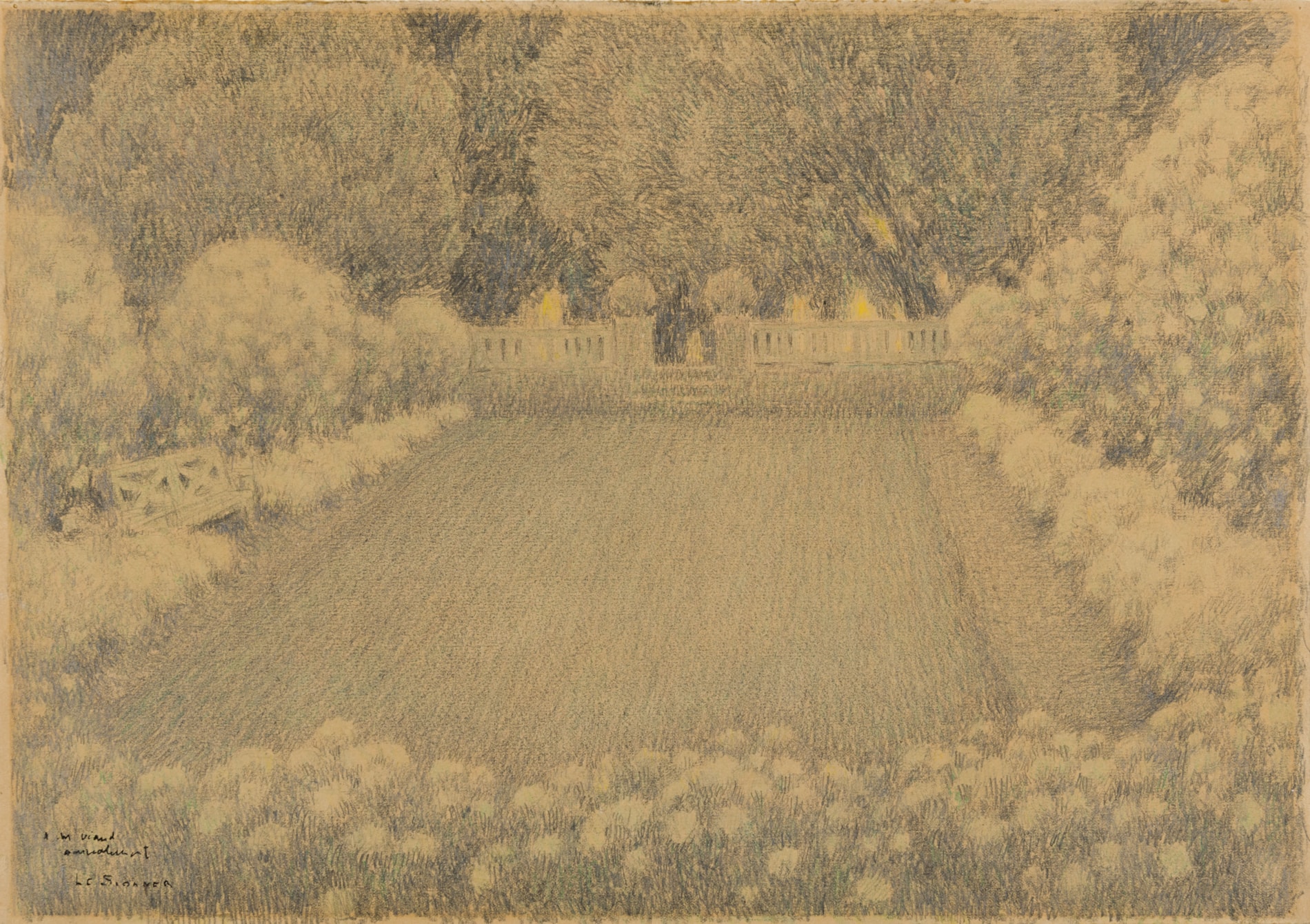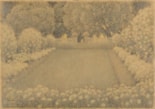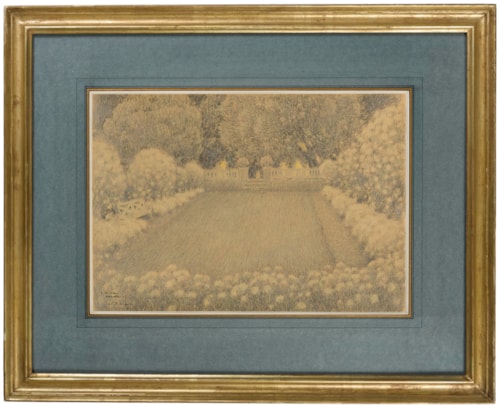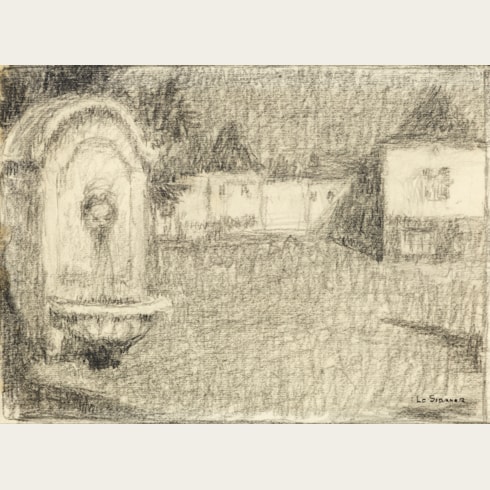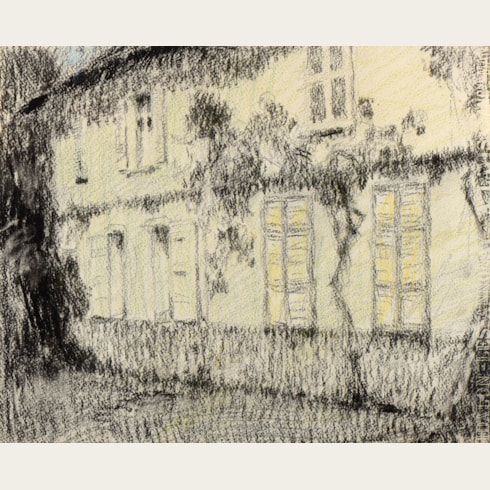Henri LE SIDANER
(Port-Louis 1862 - Versailles 1939)
The White Garden at Gerberoy (Le jardin blanc)
Pencil and coloured pencil on buff paper.
Signed and dedicated a M Viaud / amicalement / LE SIDANER at the lower left.
250 x 356 mm. (9 7/8 x 14 in.)
Signed and dedicated a M Viaud / amicalement / LE SIDANER at the lower left.
250 x 356 mm. (9 7/8 x 14 in.)
Drawn in 1912, this drawing depicts one of Henri Le Sidaner's favourite subjects; his house at Gerberoy, which he once described as his ‘haven of peace’. The artist had first visited the village of Gerberoy in 1901, at the suggestion of Auguste Rodin, and soon purchased a house there, creating a large garden that provided him with a myriad of subjects and motifs for his paintings. Le Sidaner often depicted the gardens and the façade of the house, studying the tonal effects and play of light at various times of day and in different seasons. As Camille Mauclair wrote, ‘The house is relatively constant, despite the changes in appearance which the seasons may bring. However, the thoughts and sensibilities of the man who inhabits and loves this place are constantly renewed – and this is why the subject is never monotonous. The pictures Le Sidaner paints in Gerberoy are, more than any others, expressions of his moods. And the way he presents these moods, varying them indefinitely, is the pictorial result of his talent for arrangement, for fitting the scene to the frame – this is a talent he possesses to the highest degree.’ Like most of the artist’s landscapes and town scenes, the views of the house at Gerberoy are almost always devoid of figures.
This drawing is a finished preparatory study for Le Sidaner’s large painting Le jardin blanc au crépuscule of 1912, which was acquired, the year after it was painted, by the Musées Royaux des Beaux-Arts de Belgique in Brussels. The painting depicts the so-called white garden, decorated with white flowers, that was created by the artist soon after he acquired the property at Gerberoy: ‘At the top of the four steps facing the house…Le Sidaner designed a white garden in which a small, rectangular lawn, lined with gravel paths, was surrounded by weeping rose tries and carnations. The enclosed, fragrant terrace was especially beguiling at twilight…The glory of the white garden was to be fleeting; the rose trees were decimated in the harsh winter of 1917 and replaced by hardier species with longer blooming periods.’ Also preparatory for the Brussels painting is a slightly larger oil sketch on panel of the same composition, which was in a private collection in 1989.
The present sheet was given by Le Sidaner to Gabriel Viaud, called Jean Viaud-Bruant (1865-1948), a noted French horticulturalist, flower breeder and garden designer from Poitiers who was also a collector of modern art. This drawing was used as the cover of the fifth edition of Viaud-Bruant’s book Les Peintres-Jardiniers, in which the author writes of the subject: ‘The profound artist Le Sidaner created a White Garden, solely composed of white flowers, in his Thebaid of Gerberoy (Oise); there he produced paintings of great merit in the evening, at dusk and in the moonlight. This philosopher is the type of the painter-poet...His thought is condensed in a brushstroke, in the placement of a hue; he paints like a visionary, a rare quality. The wall of his house are walls behind which something happens, and what an intense feeling of intimacy, what an extraordinary caress of soft light is spread everywhere! Le Sidaner seduces us like a poet, because he has likewise the gift of fleeting images, the same richness, the same colourful inventiveness, the same luminous quivering, the same intuition, to which he adds the glow and the phosphorescence of the world. A painter-poet is one who thinks and expresses himself in colour.’
This drawing is a finished preparatory study for Le Sidaner’s large painting Le jardin blanc au crépuscule of 1912, which was acquired, the year after it was painted, by the Musées Royaux des Beaux-Arts de Belgique in Brussels. The painting depicts the so-called white garden, decorated with white flowers, that was created by the artist soon after he acquired the property at Gerberoy: ‘At the top of the four steps facing the house…Le Sidaner designed a white garden in which a small, rectangular lawn, lined with gravel paths, was surrounded by weeping rose tries and carnations. The enclosed, fragrant terrace was especially beguiling at twilight…The glory of the white garden was to be fleeting; the rose trees were decimated in the harsh winter of 1917 and replaced by hardier species with longer blooming periods.’ Also preparatory for the Brussels painting is a slightly larger oil sketch on panel of the same composition, which was in a private collection in 1989.
The present sheet was given by Le Sidaner to Gabriel Viaud, called Jean Viaud-Bruant (1865-1948), a noted French horticulturalist, flower breeder and garden designer from Poitiers who was also a collector of modern art. This drawing was used as the cover of the fifth edition of Viaud-Bruant’s book Les Peintres-Jardiniers, in which the author writes of the subject: ‘The profound artist Le Sidaner created a White Garden, solely composed of white flowers, in his Thebaid of Gerberoy (Oise); there he produced paintings of great merit in the evening, at dusk and in the moonlight. This philosopher is the type of the painter-poet...His thought is condensed in a brushstroke, in the placement of a hue; he paints like a visionary, a rare quality. The wall of his house are walls behind which something happens, and what an intense feeling of intimacy, what an extraordinary caress of soft light is spread everywhere! Le Sidaner seduces us like a poet, because he has likewise the gift of fleeting images, the same richness, the same colourful inventiveness, the same luminous quivering, the same intuition, to which he adds the glow and the phosphorescence of the world. A painter-poet is one who thinks and expresses himself in colour.’
The son of a naval officer, Henri Le Sidaner was born on the island of Mauritius and studied at the Ecole du Dessin in Dunkirk. Although he also spent some time in the studio of Alexandre Cabanel at the Ecole des Beaux-Arts in Paris, which he entered in 1880, Le Sidaner eventually gave up this academic training and in 1882 settled in the coastal town of Étaples, in the Pas de Calais in northern France. There he lived and worked for the next twelve years in isolation, painting views of the surrounding countryside and genre scenes of peasant life. In 1887 he exhibited for the first time at the Salon des Artistes Français in Paris, and he continued to exhibit there yearly until 1893, after which he began showing at the rival Société Nationale des Beaux-Arts. In 1894, the same year that he first sent his work to the Salon de la Société Nationale des Beaux-Arts, Le Sidaner returned from Étaples to live in Paris. From 1899 onwards, he enjoyed an exclusive arrangement with the Galerie Georges Petit, which handled the sale of all of his paintings until the closure of the Parisian gallery in 1931.
Around 1901 Le Sidaner settled in the small medieval village of Gerberoy, in the Oise department on the border of Normandy and Picardy, where he built a studio and garden and worked until the end of his life. His house at Gerberoy became the dominant subject of his mature work, providing him with motifs and inspiration for nearly forty years. As the artist’s friend and early biographer Camille Mauclair, writing in 1928, noted, ‘he had the good fortune to find an atmosphere and surroundings that suited his nature and his ideas. He was destined to paint much of France, but Gerberoy was and remains his asylum pacis and family home.’ Apart from his travels around France, Le Sidaner also painted in Venice, London and around Lake Maggiore in Italy. In 1910 he was given a retrospective exhibition at the Galerie Georges Petit, while a room was devoted to his work at the Venice Biennale of 1914. In 1930 Le Sidaner was at last admitted into the Académie des Beaux-Arts, a triumph for a painter who had worked outside official circles for most of his career.
Le Sidaner delighted in capturing transient effects of light, and would paint scenes in bright sunshine, twilight, moonlight or even artificial light. As one American critic, writing in 1906, noted of Le Sidaner, ‘His art expression lies somewhere between that of Corot and that of Claude Monet. It is elusive and delightful and stamps him as one of the most original, one of the most exquisite of France’s younger painters…What Sidaner does not know about light and the method of reflecting it on a canvas seems scarcely worth knowing…’
While Le Sidaner often made sketches and drawings sur le motif, his paintings themselves were generally painted from memory rather than direct observation. He was able to achieve remarkable effects of solitude and serenity in his pictures, and chose his compositions carefully to heighten the poetic mood. As another contemporary critic wrote, ‘corners of small towns in winter, glum suburbs, a farm with pallid windows, streets with echelons of feeble, pensive lights form a decor which gives the best possible expression to Le Sidaner's exquisite sensitivity.’ Another French critic, Roger Marx, aptly described the artist’s paintings as redolent of a ‘feeling of peace, of silence and of mystery’.
Around 1901 Le Sidaner settled in the small medieval village of Gerberoy, in the Oise department on the border of Normandy and Picardy, where he built a studio and garden and worked until the end of his life. His house at Gerberoy became the dominant subject of his mature work, providing him with motifs and inspiration for nearly forty years. As the artist’s friend and early biographer Camille Mauclair, writing in 1928, noted, ‘he had the good fortune to find an atmosphere and surroundings that suited his nature and his ideas. He was destined to paint much of France, but Gerberoy was and remains his asylum pacis and family home.’ Apart from his travels around France, Le Sidaner also painted in Venice, London and around Lake Maggiore in Italy. In 1910 he was given a retrospective exhibition at the Galerie Georges Petit, while a room was devoted to his work at the Venice Biennale of 1914. In 1930 Le Sidaner was at last admitted into the Académie des Beaux-Arts, a triumph for a painter who had worked outside official circles for most of his career.
Le Sidaner delighted in capturing transient effects of light, and would paint scenes in bright sunshine, twilight, moonlight or even artificial light. As one American critic, writing in 1906, noted of Le Sidaner, ‘His art expression lies somewhere between that of Corot and that of Claude Monet. It is elusive and delightful and stamps him as one of the most original, one of the most exquisite of France’s younger painters…What Sidaner does not know about light and the method of reflecting it on a canvas seems scarcely worth knowing…’
While Le Sidaner often made sketches and drawings sur le motif, his paintings themselves were generally painted from memory rather than direct observation. He was able to achieve remarkable effects of solitude and serenity in his pictures, and chose his compositions carefully to heighten the poetic mood. As another contemporary critic wrote, ‘corners of small towns in winter, glum suburbs, a farm with pallid windows, streets with echelons of feeble, pensive lights form a decor which gives the best possible expression to Le Sidaner's exquisite sensitivity.’ Another French critic, Roger Marx, aptly described the artist’s paintings as redolent of a ‘feeling of peace, of silence and of mystery’.
Provenance
Presented by the artist to Gabriel (Jean) Viaud-Bruant, Poitiers
Galerie Paule Cailac, Paris
Galleries Maurice Sternberg, Chicago
Worthington Gallery, Chicago, in 1979
Elaine and Perry Snyderman, Highland Park, Illinois.
Galerie Paule Cailac, Paris
Galleries Maurice Sternberg, Chicago
Worthington Gallery, Chicago, in 1979
Elaine and Perry Snyderman, Highland Park, Illinois.
Literature
Jean Viaud-Bruant, Jardins d’artistes: Les Peintres-Jardiniers, Poitiers, 1916 [5th ed.], illustrated on the cover and also between pp.38 and 39; Yann Farinaux-Le Sidaner, Le Sidaner: L’oeuvre peint et gravé, Paris, 1989, p.337, no.1025.
Exhibition
Possibly Paris, Musée Galliera, Rétrospective Henri Le Sidaner, April 1948; Chicago, Galleries Maurice Sternberg, 19th and 20th Century Masters, 1976.

